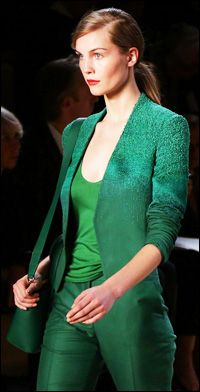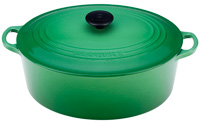
2013 ‘It’ color Emerald
Selected as ‘2013 Color of the Year’ by Pantone, the refreshing shade of emerald green brings a sense of rejuvenation to a multitude of designs, from home decor to fashion runways worldwide.
Expect more green in 2013

Customers can expect to see more green in fashion and home decor this year.
Emerald was recently selected as the “2013 Color of the Year” by Pantone, a U.S. firm that sells codes that manufacturers use to replicate colors on a variety of materials, from plastic to paint. The company determines the color of the year through a survey of experts in fashion, interior and other designers.
Pantone’s annual color proclamation is closely followed by the design industry, and emerald is already showing up in a variety of areas, including fashion, home decor, cars and kitchenware.
Emerald has been seen on runways for the 2013 spring collection of renowned labels like Valentino, Dolce & Gabbana, Marni and Akris. It is the key color of Le Creuset’s kitchenware, a popular brand among Korean housewives. GM introduced a Camaro convertible in Las Vegas this fall in a rich green color.
Le Creuset is selling a full range of cookware in a deep green called fennel.
The shade of the year is the color of a four leaf clover and is associated with rejuvenation, luck, freshness and growth.
Emerald is “lively, radiant, and lush. A color of elegance and beauty that enhances our sense of well-being, balance, and harmony,” according to Pantone.
Emerald is a departure from the passion of this year’s color of the year Tangerine Tango, which was used to create a makeup line in partnership with Sephora.
Top three cultural trends

Each year, the culture ministry publishes a report predicting cultural trends for the upcoming year. The report will be available on the website of the Korea Culture & Tourism Institute at www. kcti.re.kr on Dec. 31.
Here are the top three cultural trends for 2013, as selected through a poll of culture experts in academia and the media, as well as artists.
Healing through culture
Koreans are not happy. According to the U.N., Korea placed 56th among 150 countries in its “World Happiness Report,” published in April this year. Against this backdrop, people are becoming more interested in how we can become happier. This explains why “healing” has been the keyword of many TV programs and books this year and this is expected to continue next year, the culture ministry said.
The cultural sector, media and the publishing industry has been flooded with content related to healing the mind and offering relaxation, like “Healing Camp,” a talk show on SBS. Another relevant phenomenon is the popularity of “healing books” like “It Hurts Because You’re Young” by Kim Nan-do, which sold over 1.3 million copies this year.
From K-pop to K-culture
“Hallyu” or the Korean wave is not just about pop songs and TV dramas any more.
This is what culture officials would like the world to know, particularly as there are rising concerns about the longevity of hallyu among some experts.
Next year, there will be more efforts to introduce Korea’s cultural assets to the outside world, like Korea National Ballet’s new production set to the music of the “gayageum,” a traditional 12-stringed zither-like Korean instrument.
There will also be more efforts to promote “Hangeul,” the Korean alphabet.
Due to rising interest in the nation’s culture, more foreigners are showing interest in learning Korean. To deal with the rising demand in Korean language education, Seoul has opened more King Sejong Institutes for teaching Korean abroad and additional Korean cultural centers abroad.
New breed of entertainers
Audition programs are likely to remain a big trend on TV next year.
A surge in the popularity of these shows has led to a new breed of entertainers.
At a time when the pop scene was dominated by young idol groups who are recognized more for dancing than singing, programs like “Superstar K 3” or “I Am a Singer” have recognized true aspiring talent and have made stars out of the contestants. <The Korea Times/Do Je-hae>


